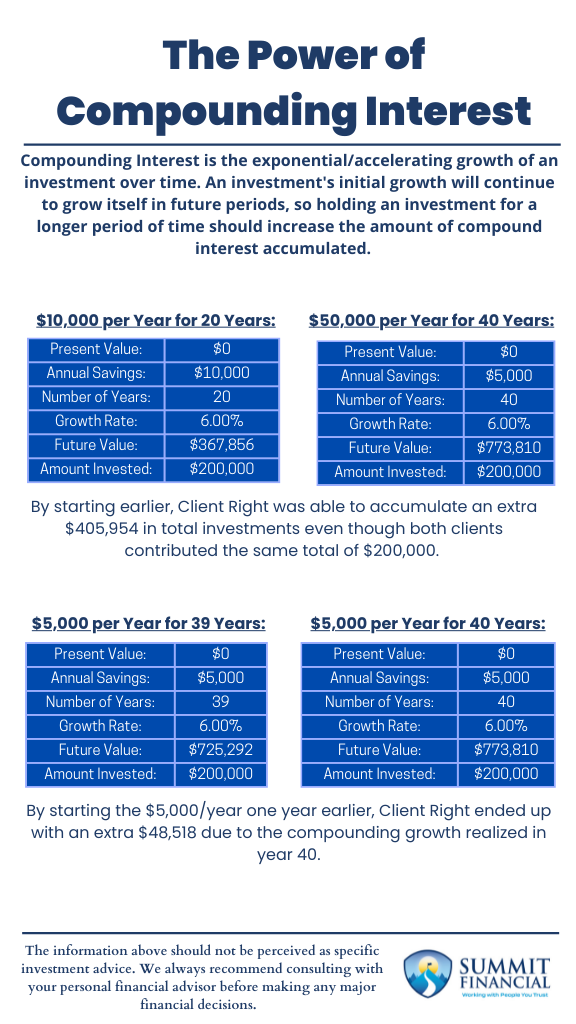Most people recognize the phrase, “a penny saved is a penny earned.” And while this quote is typically considered as a way to view savings vs. spending, this phrase actually explains this article’s topic as well. In terms of investing, a penny invested could grow and earn a penny. In general, Time Value of Money is how we view the value of money today compared to the value of money in the future. This article is going to explain why we believe a dollar today is truly worth more than a dollar tomorrow. There are two main reasons why we believe this statement is true: Inflation and Compounding Interest.
What is Inflation?
First, inflation is the increase in the price of goods over time. Historically, inflation has averaged between 2% and 3% per year. If the price of a candy bar is $1.00 today and inflation is 3% for the year, this same candy bar is going to cost $1.03 after the next 12 months. If you had a crisp George Washington in your wallet for the entirety of those 12 months, you will not be able to afford the candy. However, you would be able to afford it if you were to buy one today. A dollar is worth more today, because you can buy more goods today than you will be able to after the impact of inflation.
Second, compounding interest is the potential for invested money to grow at an exponential rate. Meaning, the longer the money is invested then the faster the money can grow. For example, if an individual invested $100 and earned a hypothetical 10% their first year, they would have $110 after 12 months.
If they earned 10% the following year as well, they would have gained $11 and have a new total of $121. Another 10% year would yield $12.10 in gains and the new balance would be $133.10. As you can see, even though no additional contributions were made, the balance in the account grows more and more every year despite earning a consistent 10% each year. This is because the growth in the account can grow in addition to the initial premium.
In order to calculate the time value of money, you need 4 of 5 variables. The 5th variable you are looking to solve for and you will be able to as long as you have the remaining 4. The variables are: Present Value, Future Value, Annual Contributions/Withdrawals, Number of Years, and Annual Rate of Return. Please see the example below to see the impact of investing sooner rather than later.

How to Calculate Time Value of Money
In order to calculate the time value of money, you need 4 of 5 variables. The 5th variable you are looking to solve for and you will be able to as long as you have the remaining 4. The variables are: Present Value, Future Value, Annual Contributions/Withdrawals, Number of Years, and Annual Rate of Return.
Please see the example below to see the impact of investing sooner rather than later.
| $10,000 per Year for 20 Years | $5,000 per Year for 40 Years | |
|---|---|---|
| Present Value | $0 | $0 |
| Annual Savings | $10,000 | $5,000 |
| Number of Years | 20 | 40 |
| Growth Rate | 6% | 6% |
| Future Value | $367,856 | $773,810 |
| Difference in Future Value | $405,954 | |
| Amount Invested | $200,000 | $200,000 |
As you can see, even though the same amount was invested, there is a $400,000 potential difference just by starting sooner. This difference in the Future Values is the result of compounding interest. Because the individual on the right started sooner, they were able to get growth into their account sooner and had a longer period of time for that growth to grow on top of itself. Below is an example that illustrates only a 1-year difference:
| Scenario 1: $5,000 per Year for 39 Years | Scenario 2: $5,000 per Year for 40 Years |
|---|---|
| Present Value: $0 | Present Value: $0 |
| Annual Savings: $5,000 | Annual Savings: $5,000 |
| Number of Years: 39 | Number of Years: 40 |
| Growth Rate: 6% | Growth Rate: 6% |
| Future Value: $725,292 | Future Value: $773,810 |
| Difference in Future Value: $48,518 | |
| Amount Invested: $195,000 | Amount Invested: $200,000 |
As you can see, by delaying savings by one year, the individual on the left actually lost out on $48,000. $5,000 of this was the savings for one year, but the remaining $43,000 is the amount of compounded growth lost. People always say, “It’s okay. I’ll start saving next year. One year cannot hurt anything.” When in reality, when you delay savings for one year, you are not missing out on the first year of gains. You are missing out on the last year of gains and that is when the account will have the most compounded growth.
All content is for information purposes only. It is not intended to provide any tax or legal advice or provide the basis for any financial decisions. Nor is it intended to be a projection of current or future performance or indication or future results. The information provided is not based on actual current or past clients. All situations are unique, and results will differ depending on the individual situation.
Financial Planning and Review Meeting
If you have any questions about your investment portfolio, tax strategies, our 401(k) recommendation service, or other general questions, please give our office a call at (586) 226-2100. Please feel free to forward this commentary to a friend, family member, or co-worker. If you have had any changes to your income, job, family, health insurance, risk tolerance, or your overall financial situation, please give us a call so we can discuss it.
We hope you learned something today. If you have any feedback or suggestions, we would love to hear them.
Zachary A. Bachner, CFP®
If you found this article helpful, consider reading:
- Navigating College Funding
- Financial Planning Mistakes to Avoid
- Debt Repayment Strategies
- How to Negotiate a Raise
Disclosures regarding our performance reporting: Because some clients are in the 10% tax bracket and others are in the 37% Federal tax bracket, we have decided to report performance before taxes. If you have a non-qualified account, please feel free to contact us to determine your individualized rate of return after tax. All of Summit’s performance is after our 1.25% advisory fee that is deducted monthly. Your fees may be higher or lower depending upon the amount of assets invested with our firm. Feel free to contact us to receive online access so you can see your personalized rate of return. The Aggregate bond index we use is ticker: AGG. All dividends and distributions are reinvested and included in the performance. The S&P 500 index quoted above does not include dividends within the performance. If a holding within our portfolio does pay a dividend or other income, it is reinvested, so our performance does include dividends. This report has been prepared from data believed reliable, but no representation is made as to accuracy or completeness. Total return and principal value will vary depending upon the deduction of advisory fees, brokerage commissions, reinvestment of dividends, and other earnings or fund charges. This information is provided to you in combined form, solely for your convenience and ease of review, and is not an offer or solicitation to buy or sell any securities. In order to verify that all account values and transactions are accurate, we encourage you to compare the information provided in our statement with the statement you receive directly from your custodian. All written content is for information purposes only. It is not intended to provide any tax or legal advice or provide the basis for any financial decisions. Past performance does not guarantee future results.


